Leigh Camera Club
LEIGH CAMERA CLUB HISTORY
Extracts
from
John
West’s
A
History
of
Leigh
Camera
Club.
Covering
some
of
the events down the years.
THE EARLY DAYS
Leigh
Camera
Club
was
formed
in
the
year
1929.
Our
history
will
cameo
events
from 1945 to 1990.
The
20th
August
1945
is
the
first
evidence
of
the
renewal
of
its
activities
after
the
war
years.
A
security
ban
on
taking
photos
anywhere
in
the
country
has
been
lifted
in
June
1945.
Mr
Kind
had
been
President
of
the
club
in
the
pre-
war
years
and
printed
syllabuses
of
that
time
show
that
there
was
a
committee
of
four
officers.
There
was
a
modest
programme
of
events
at
fortnightly
intervals.
During
the
war
Mr
Kind
had
died
and
former
secretary,
Mr
E.
W.
Guildersleeves,
and
a
Mr
Johnson
called
a
meeting
with
a
view
of
reviving
the
club.
Seventeen
people
attended
this
August
20th
meeting
and
the
club
was
once
more
on
its
way.
Notes
dated
September
6th
1945
‘a
motley
assortment
of
camera-
Leicas,
Retinass,
Rolleiflex,
Plate
reflexes-
were
produced
at
the
first
meeting
which
was
devoted
to
reminding
members
of
‘What
your
camera
can
do’.
In
the
early
days
a
club
was
judged
by
its
portfolio.
This
was
a
collection
of
its
best
prints
that
circulated
round
various
photographic
clubs.
Each
club
added
comments
and
critiques
on
the
individual
entries.
This
was
a
slow
process
and
of
interest
to
the
contributors
only.
The
records
show
only
one
identifiable
outside
speaker
at
this
time,
although
the
club
was
rich
in
expertise
even
then.
The
club
was
living
through
the
post-war
period
of
austerity
in
which
the
country
was
struggling
to
adapt
to
its
production
of
peacetime
needs.
Luxuries
like
film
and
equipment
were
in
very
short
supply.
Photographers
combed
the
classified
ads
in
the
‘Amateur
Photographer’
looking
for
off
cuts
of
35mm
film
that
might
be
for
sale.
Times
were
tough
and
this
probably
led
to
the
new
born
club’s
difficulties.
From
the
sketchy
minutes
of
1949
there
was
talk
of
joining
forces
with
the
Benfleet
Urban
District
Arts
and
Craft
Council,
later
there
was
a
move
to
combine
with
Hadleigh
Camera
Club but this did not happen.
For
many
years
this
was
all
that
could
be
ascertained
from
the
club’s
records
of
those
early
days.
Then
in
1979
a
Mr
Bernard
Seaward
re-joined
the
club,
just
after
the
information
above
had
been
serialised
in
the
club
magazine
‘Stop
Press’.
He
was
probably
the
earliest
living
member
of
the
club,
having
originally
joined
at
the
age,
he
thought
of
13
in
1933.
He
gave
an
insight
into
those
very
early
days
of
the
club,
when
its
half
dozen
members
hired
a
front
room
of
one
of
the
tiny
houses
in
the
Leighville
Grove,
only
a
couple
of
streets
away
from
our
present
location
in
Elm
Road.
He
recalled
many
photographic
expeditions
and
picnics
in
the
countryside
and
a
visit
to
a
house
of
a
lady
to
see
a
lantern
slide
show.
He
was
impressed
by
the
projector,
which
glowed
red-hot
and
had
a
little
cowled chimney on the top to allow the fumes to escape.
THE FIFTIES
The
first
two
years
of
the
new
decade
the
club
was
pulled
from
the
brink
of
closing
down
by
the
able
chairmanship
of
Mr
R.
C.
Golding
and
Mr
Fred
Clark.
Within
two
more
years
it
was
to
become
a
thriving
body
with
a
full
and
exciting
programme
with
a
healthy
bank
balance.
This
amazing
transformation
was
due
to
one
man,
Hubert
cave
Thompson.
Universally
known
as
Tommy
he
joined
the
club
in
1951
with
a
membership
of
only
25
and
an
average
of
15
attending
meetings.
The
club
was
a
vicious
circle,
without
an
increase
in
members
it
could
not
mount
an
attractive
programme,
without
an
attractive
programme
it
could
not
increase
the
members.
To
progress
the
club
needed
to
obtain
outside
knowledge
from
sponsored
lectures
such
as
Kodak
and
Ilford,
but
this
required
a
minimum
membership
of
40.
Tommy
set
about
the
task
of
increasing
membership.
Tommy
being
Tommy,
he
went
ahead
and
booked
an
Ilford
Lecture
for
the
next
season
with
the
promise
that
he
would
fulfil
all
the
conditions
required.
The
next
season
duly
opened
and
the
members
had
done
their
stuff
and
the
season
was
a
great
success.
Tommy
woke
up
in
1954
to
find
himself
chairman
and
Mr
Jim
Rogers
as
Honorary
Secretary.
The
next
ruse
Tommy
used
was
to
insert
a
notice
in
the
local
paper’s
announcing
that,
due
to
the
overwhelming
number
of
requests
for
membership
that
year
Leigh
on
Sea
Camera
Club
would
have
to
limit
its
entry
to
just
one
hundred.
The
public
were
advised
to
make
early
application
to
join.
It
was
no
use
enticing
members
to
the
club
if
there
was
nothing
to
keep
them
there.
Here
Tommy
played
his
master-stroke.
Capitalising
on
his
love
of
portraiture,
he
organised
a
series
of
studio
nights,
presented
mostly
by
himself
but
also
by
experts
like
Philip
Gotlob,
nationally
famous
for
his
‘pin
up’
photos.
The
models
were
of
course
mainly
pretty
girls.
These
studio
nights
proved
extremely
popular
and
was
typical
of
Tommy
that
he
shrewdly
programmed
these
nights
early
in
the
season
and
made
admission
dependant
on
a
membership
card,
thus
ensuring
that
waverers
had
to
make
up
their
minds
and
that
sums
were
quickly
gathered.
Studio
nights
soon
developed
into
his
famous
‘Glamour
Nights’
often
held
in
a
studio
above
his
premises
at
Pavilion
Motors.
The
first
was
held
at
Elm
Road
Community
Centre
in
1956.
A
glimpse
of
what
this
first
evening
must
have
been
like
is
revealed
by
this
extract
from
‘Viewfinder’,
the
clubs
bulletin:
Beauty
on
the
Beach.
Pheeew!
One
of
Tommy’s
special
nights.
Glamour
oozing
all
over
the
place.
Red-hot
shutters.
Everyone
happy
except
a
man
who
said
he
would
have
preferred
to
have
the
boat
that
Tommy
had
lugged
into
the
hall,
upstairs.
Tommy
had
not
only
the
boat,
but
a
bathing
hut,
and
a
large
painted
backdrop
scrounged
from
the
swimming
pool, sand and lobster pots, the lot, 86 attended.
In
1952
the
club
had
presented
two
outside
speakers.
In
1956
the
figure
was
eleven.
The
membership
could
at
last
attract
lecturers
of
the
calibre
of
R.
H.
Mason,
editor
of
the
Amateur
Photographer,
at
the
time
the
outstanding
photographic
magazine.
Tommy
made
no
secret
of
the
fact
that
in
1952
he
joined
the
prestigious
London
Camera
Club
principally
to
contact
such
personalities
with
a
view
to
inviting
to
Leigh.
One
such
person
was
Major
Mike
Davis,
a
well
known
theatrical
photographer.
He
had
married
the
Baroness
Anne
von
Granvenitz
and
Tommy
invited
her
to
present
the
prizes
at
he
club’s
26th
Annual
Exhibition.
Jim
Rogers,
then
secretary,
discovered
that
this
gallant
lady
had
suffered
at
the
hands
of
the
Gestapo
for
her
part
in
helping
prisoners
of
war
to
escape
this
sensational
story
skilfully
exploited
by
Jim
in
the
local
press,
resulted
in
a
coach
load
of
visitors
from
London
arriving
on
the
night
to
swell
the
audience
in
the
hall
to
no
fewer
than
four
hundred.
Another
guest
was
the
Marquis
of
Ely,
then
president
of
the
Royal
Photographic
Society
and
an
authority
on
colour
and
stereo
photography.
He
presented
the
prizes
at
the
annual
exhibition
of
1956.
By
the
end
of
the
decade
membership
was
140
and
the
attendance
at
meetings
usually
was
in
the
60s
or
70s.
In
1959,
as
in
the
year
before,
the
Annual
Exhibition
was
patronised
by
no
fewer
than
a
thousand
people.
The
Fifties
had
been
a
runaway
success
but
the best was yet to come.
THE SIXTIES
In
November
1962
Southend
was
twinned
with
Calais
and
Leigh
Camera
Club
made
its
contribution
to
European
unity
by
arranging
a
slide
battle
with
the
Foto
Club
de
Calais.
Another
event
in
which
the
club
played
a
prominent
part
was
the
Southend
Show,
both
in
1959
and
1960.
This
embraced
everything
from
bee
keeping
to
weaving
and
housed
a
pavilion
of
photography,
largely
organised
by
Leigh
with
the
help
of
Hadleigh
Photographic
Club,
the
Shell
Club
and
the
Southend
Photographic
Society.
It
presented
a
continual
slide
show,
exhibitions
of
prints
and
three
days
of
demonstrations,
performed
principally
by
Tommy.
Another
of
his
contributions
was
a
series
of
aerial
photos
of
the
town
forming
a
40
long
frieze.
All
these
events
added
to
the
club’s
reputation
and,
more
surprisingly,
membership.
In
1963
it
was
chosen
as
the
venue
for
the
premiere
of
the
first
Kodak
Colour
Show.
This
was
attended
by
400
people
and
100
had
to
be
turned
away.
In
that
year
our
membership
rose
to
its
highest
point
so
far:
250.
Small
wonder
the
club
could
draw
a
galaxy
of
photographic
selections:
James
Jarche,
Karl
Pollack,
Houston
Rogers
and
names
retaining
their
fame
today,
Kevin
McDonnel,
Ron
Spillman
and
Jorge
Lewinski.
At
the
1963
Annual
General
Meeting
Tommy
announced
that
he
did
not
intend
to
stand
again
as
Chairman.
A
‘bombshell’
the
local
press
called
it
and
feared
the
collapse
of
the
club,
as
Tommy
was
the
driving
force
within
the
club.
A
new
Chairman,
Wilf
Goodwin,
was
then
elected
and,
to
the
relief
of
all,
a
new
position
was
found
for
Tommy,
that
of
~President.
Wilf
Goodwin
was
perhaps
the
leading
figure
in
the
club
in
the
last
half
of
the
Sixties
and
into
the
Seventies.
He
had
made
a
study
of
black
and
white
technique
and
his
precepts
in
this
field
were
to
influence
many
of
the
club’s
then
new
photographers,
like
Peter
Millard
and
David
Davenport
who
were
to
win
their
laurels,
first
in
club
competitions,
and
then
go
on
to
make
their
mark
outside.
It
is
interesting
to
compare
the
syllabuses
of
the
Fifties
with
those
of
the
Sixties
and
see
the
sweeping
changes
that
have
overtaken
photography,
which
had
the
committee
constantly
drafting
the
competition
rules
during
this
period.
Stereo
photography
was
fast
waning
and
by
1974
there
would
be
the
problem
of
what
to
do
with
the
Marquis
of
Ely’s
bowl
for
this
category.
The
medium
format
negative
was
ceasing
to
be
a
serious
contender
to
35mm.
Cine
had
gradually
come
to
be
seen
as
a
separate
discipline.
Although
colour
printing
had
been
demonstrated
at
the
club
as
early
as
1955,
the
first
slide
and
then
colour
prints
began
to
threaten
the
supremacy
of
black
and
white.
In
1969
the
Print
of
the
Year
was
joined
by
the
Slide
of
the
year.
More
significantly
the
old
sponsors
of
photography,
such
as
Kodak,
Ilford
and
Agfa
were
being
joined
or
supplanted
by
names
from
the
Far
East,
such
as
Pentax,
Minolta
and
Nikon.
A
sea
of
change
was
taking
place
in
photography
that
in
Seventies
was
to
become an irresistible tide.
THE SEVENTIES
The
difficulties
were
financial
and
were
to
come
to
a
head
in
middle
of
the
decade
but
the
good
times
were
due
to
the
interest
in
photography
among
the
general
public
this
was
mainly
the
results
of
the
advance
of
electronics
which
began
in
the
Sixties.
The
coming
of
cheap
automatic
cameras
put
an
end
to
the
public’s
perception
that
only
experts
could
achieve
good
pictures.
Electronics
also
gave
photography
increased
appeal
to
the
technically
minded.
Another
beneficiary
of
Electronics
was
the
slide
show
which
with
its
aid,
was
to
become
almost
another
art
form,
the
audio-visual
or
AV
show.
These
were
a
far
cry
from
our
‘Lantern
Talks
in
1955
audio
visual,
starting
with
the
Synchro-slide
Show
of
1972
using
manually
controlled
slides
changes,
must
surely
have
culminated
in
1982
with
the
computer
controlled
‘Spectacular
using
no
less
that
8
projectors.
Yet
despite
the
dedication
of
members,
the
seventies
were
worrying
times
for
the
club.
In
1974
the
minutes
begin
to
record
evenings
lost
through
fuel
cuts
and
rail
strikes.
This
was
the
period
of
the
three-
day
week
and
more
seriously
for
the
club,
of
rapidly
rising
inflation.
By
the
middle
of
the
decade
rising
costs
began
to
cause
worries
about
the
viability
of
the
club.
In
1970
the
membership
was
140
but
had
been
declining
ever
since.
The
committee
was
only
too
aware
that
around
us
were
rival
clubs,
born
in
late
Sixties
and
Seventies,
Canvey,
Wickford,
Basildon,
Billericay,
Benfleet
and
Rayleigh
all
within
easy
motoring
distance
and
eager
to
absorb
our
membership.
No
one
could
know
that
membership
decline
would
bottom
out
in
1976
at
106.
By
1975
the
subscription
had
doubled.
Another
shock
came
when
the
Borough
Council
was
absorbed
into
Essex
County
Council.
Everyone
expected
a
substantial
rise
in
the
hiring
fee
for
the
Community
Centre
where
we
were
housed
but
no
one
was
prepared
for
the
increase
of
25%
that
materialised.
It
was
then
that
Tommy,
noting
the
favourable
terms
given
to
Adult
Education
classes
had
an
idea.
He
arranged
a
meeting
at
the
Civic
Centre
where,
using
all
his
considerable
powers
of
persuasion;
he
convinced
county
officials
that
many
of
the
club’s
evenings
were
infact
educational.
Reluctantly
discount
was
given
for these meetings – as it still is – and our hiring was reduced. Leigh had weathered this storm.
THE EIGHTIES
Throughout
the
Eighties
the
club
continues
to
evolve,
a
significant
development
was
the
institution
by
John
Dakin
LRPS
of
the
Challenge
Trophy,
still
going
to
date.
John
noted
for
his
photographic
creativity,
wanted
to
give
an
opportunity
for
members
to
break
out
of
conventional
moulds
of
competition
categories
such
as
landscape,
natural
history,
etc.
His
object
in
framing
the
rules
of
the
Challenge
Trophy
was
to
make
contestants
go
out
and
look
for
pictures
instead
of
merely
looking
through
their
existing
stock
of
negatives
and
slides.
Also
John
was
the
instigator
of
the
Beginners
Workshop,
which
again
was
a
break
from
traditions
of
the
club,
by inviting groups of new members to his house and giving varied instructions on all forms of photography.
The
Eighties
found
the
club
continuing
to
hold
its
own
with
around
120
members,
with
a
strong
committee
of
Linda
Hurst,
Peter
Millard,
Alan
Waters
and
Alf
Sclater.
Sadly
Tommy,
Alan
and
Alf
are
no
longer
with
us
but
would
have
been
pleased
with
new
members coming through onto the committee and steering the club through the Nineties into the twenty- first century.
To be continued……………………..
Southend-on-Sea

1909
Advert
for
Dawson
in
the
High
Street
&
Marine
Parade
selling
early
photographic
equipment
with
darkroom
on
the
premises
1909
Advert
for
Hillen
Pharmacist
offering a similar service to Dawson
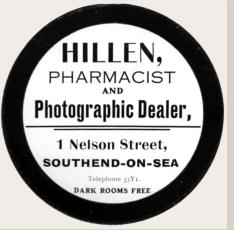
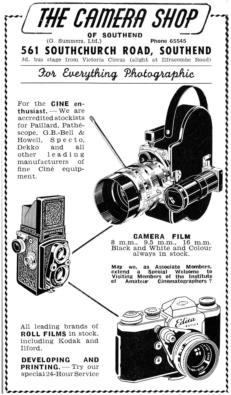

1959
Advert
for
G.
Summers
Ltd,
The Camera Shop, Southend
1968
Advert
for
J.
(Joe)
Patience
Ltd,
Queen’s
Road, Southend
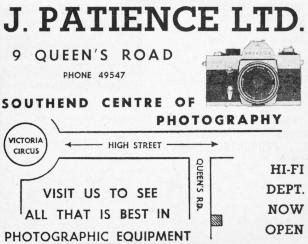
1970s
Advert
for
J.
(Joe)
Patience
Ltd,
Queen’s
Road, Southend
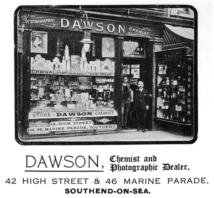
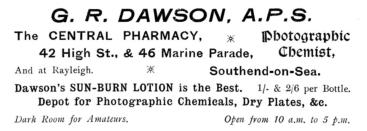
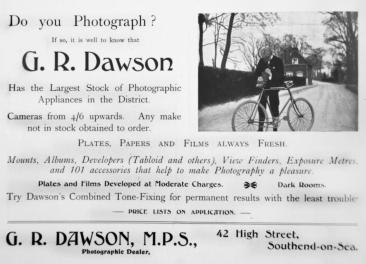
Another early advert for Dawson in the High Street
1898
Advert
for
Dawson
in
the
High
Street
&
Marine
Parade
&
at
Rayleigh.
The
photographic
chemist
with
darkroom on the premises (for amateurs)
For further information on the club and club meetings, view their website here; http://www.leighcameraclub.co.uk/
Southend Timeline Southend-on-Sea © 2009 - 2024. All Rights Reserved



SOUTHEND CITY

Southend-on-Sea’s No 1 History Website! Documenting The Town & The Townspeople
Now Incorporating The Sea Of Change Website
Website Info:


Chalkwell ▪ Eastwood ▪ Leigh-on-Sea ▪ Prittlewell ▪ Shoeburyness ▪ Southchurch ▪ Thorpe Bay ▪ Westcliff-on-Sea
































































